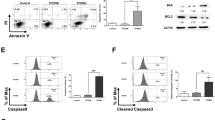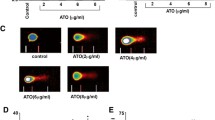Abstract
Although apoptosis and necrosis have been considered different pathways to cell death, only one compound induces both types of cell death. Diethyldithiocarbamate (DDC) has been shown to have antioxidant or prooxidant effects in several different systems. We observed in our present study that DDC induced not only apoptosis but also necrosis depending on its dosage in HL60 premyelocytic leukemia cells. Moreover, in hypoxia cell culture conditions, DDC-induced necrotic cells decreased but DDC-induced apoptosis continued. We investigated the DDC-induced different cell death mechanisms as they are correlated with reactive oxygen species (ROS). High-dose DDC-induced necrotic cell death is thought to depend on the increase of intracellular ROS, while low-dose DDC-induced apoptosis is thought to depend on changes of the intracellular redox state by the transporting of external metal ions. There was no sequential or quantitative change of Bcl-2 family proteins in DDC-induced apoptotic or necrotic pathways. However, the mitochondrial transmembrane potential was remarkably decreased in the DDC-induced necrosis. Finally, duration of c-Jun N-terminal kinase (JNK) activation resulted in different types of cell death. (Mol Cell Biochem 265: 123–132, 2004)
Similar content being viewed by others
References
Wyllie AH, Kerr JFR, Currie AR: Cell death: The significance of apop-tosis. Int Rev Cytol 68: 251–306, 1980
Kitanaka C, Kuchino Y: Caspase-independent programmed cell death with necrotic morphology. Cell Death Differ 6: 508–515, 1999
Fiers W, Beyaert R, Declercq W, Vandenabeele P: More than one way to die: Apoptosis, necrosis and reactive oxygen damage. Oncogene 18: 7719–7730, 1999
Robinson MJ, Cobb MH: Mitogen-activated protein kinase pathways. Curr Opin Cell Biol 9: 180–186, 1997
Adams JM, Cory S: The Bcl-2 protein family: Arbiters of cell survival. Science 281: 1322–1326, 1998
Shi Y: Mechanisms of caspase activation and inhibition during apopto-sis. Mol Cell 9: 459–470, 2002
Sellers EM, Naranjo CA, Peachey JE: Drug therapy: Drugs to decrease alcohol consumption. N Engl J Med 305: 1255–1262, 1981
Sunderman FW: The extended therapeutic role of dithiocarb (sodium diethyldithiocarbamate) from nickel poisoning to AIDS. Ann Clin Lab Sci 22: 245–248, 1992
Reisinger EC, Kern P, Ernst M, Bock P, Flad HD, Dietrich M, German DTC Study Group: Inhibition of HIV progression by dithiocarb. Lancet 335: 679–682, 1990
Hadjiolov D, Frank N, Moog C, Spirov K: Proline dithiocarbamate inhibits N-nitrosodiethylamine induced liver carcinogenesis. J Cancer Res Clin Oncol 118: 401–404, 1992
Hockenbery DM, Oltvai ZN, Yin XM, Milliman CL, Korsmeyer SJ: Bcl-2 functions in an antioxidant pathway to prevent apoptosis. Cell 75: 241–251, 1993
Kane DJ, Sarafian TA, Anton R, Hahn H, Gralla EB, Valentine JS, Ord T, Bredesen DE: Bcl-2 inhibition of neural death: Decreased generation of reactive oxygen species. Science 262: 1274–1277, 1993
Abello PA, Fidler SA, Bulkley GB, Buchman TG: Antioxidants mod-ulate induction of programmed endothelial cell death (apoptosis) by endotoxin. Arch Surg 129: 134–140, 1994
Hong HJ, Loh SH, Yen MH: Suppression of the development of hyper-tension by the inhibitor of inducible nitric oxide synthase. Br J Pharma-col 131: 631–637, 2000
Li WG, Coppey L, Weiss RM, Oskarsson HJ: Antioxidant therapy attenuates JNK activation and apoptosis in the remote noninfarcted myocardium after large myocardial infarction. Biochem Biophys Res Commun 280: 353–357, 2001
Long SM, Laubach VE, Tribble CG, Kaza AK, Fiser SM, Cassada DC, Kern JA, Kron IL: Pyrrolidine dithiocarbamate reduces lung reperfusion injury. J Surg Res 112: 12–18, 2003
Brennan P, O'Neill LAJ: 2-Mercaptoethanol restores the ability of nu-clear factor kB(NF-kB) to bind DNAin nuclear extracts from interleukin 1-treated cells incubated with pyrollidine dithiocarbamate (PDTC). Ev-idence for oxidation of glutathione in the mechanism of inhibition of NF-kB by PDTC. Biochem J 320: 975–981, 1996
Guchelaar HJ, Vermes I, Koopmans RP, Reutelingsperger CPM, Haanen C: Apoptosis-and necrosis-inducing potential of cladribine, cytarabine, cisplatin, and 5-fluorouracil in vitro: A quantitative pharmacodynamic model. Cancer Chemother Pharmacol 42: 77–83, 1998
Mammone T, Gan D, Collins D, Lockshin RA, Marenus K, Maes D: Successful separation of apoptosis and necrosis pathways in HaCaT keratinocyte cells induced by UVB irradiation. Cell Biol Toxicol 16: 293–302, 2000
Kimoto-Kinoshita S, Nishida S, Tomura TT: Age-related change of antioxidant capacities in the cerebral cortex and hippocampus of stroke-prone spontaneously hypertensive rats. Neurosci Lett 273: 41–44, 1999
Heikkila RE, Cabbat FS, Cohen G: In vivo inhibition of superoxide dismutase in mice by diethyldithiocarbamate. J Biol Chem 251: 2182–2185, 1976
Shimizu S, Eguchi Y, Kamiike W, Waguri S, Uchiyama Y, Matsuda H, Tsujimoto Y: Bcl-2 blocks loss of mitochondrial membrane potential while ICE inhibitors act at a different step during inhibition of death induced by respiratory chain inhibitors. Oncogene 13: 21–29, 1996
Marshall CJ: Specificity of receptor tyrosine kinase signaling: Transient versus sustained extracellular signal-regulated kinase activation. Cell 80: 179–185, 1995
Ragione FD, Cucciolla V, Borriello A, Pietra VD, Manna C, Galletti P, Zappia V: Pyrrolidine dithiocarbamate induces apoptosis by a cy-tochrome c-dependent mechanism. Biochem Biophys Res Commun 268: 942–946, 2000
Hakem R, Hakem A, Duncan GS, Henderson JT, Woo M, Soengas MS, Elia A, de la Pompa JL, Kagi D, Khoo W, Potter J, Yoshida R, Kaufman SA, Lowe SW, Penninger JM, Mak TW: Differential requirement for caspase 9 in apoptotic pathways in vivo. Cell 94: 339–352, 1998
Luo X, Budihardjo I, Zou H, Slaughter C, Wang X: Bid, a Bcl2 in-teracting protein, mediates cytochrome c release from mitochondria in response to activation of cell surface death receptors. Cell 94: 481–490, 1998
Matsumura H, Shimizu Y, Ohsawa Y, Kawahara A, Uchiyama Y, Nagata S: Necrotic death pathway in Fas receptor signaling. J Cell Biol 151: 1247–1256, 2000
Nobel CSI, Kimland M, Lind B, Orenius S, Slater AFG: Dithiocarba-mates induce apoptosis in thymocyytes by raising the intracellular level of redox-active copper. J Biol Chem 270: 26202–26208, 1995
Saitoh M, Nishitoh H, Fujii M, Takeda K, Tobiume K, Sawada Y, Kawabata M, Miyazono K, Ichijo H: Mammalian thioredoxin is a direct inhibitor of apoptosis signal-regulating kinase (ASK) 1. EMBO J 17: 2596–2606, 1998
Ichijo H, Nishida E, Irie K, ten Dijke P, Saitoh M, Moriguchi T, Takagi M, Matsumoto K, Miyazono K, Gotoh Y: Induction of apoptosis by ASK1, a mammalian MAPKKK that activates SAPK/JNK and p38 sig-naling pathways. Science 275: 90–94, 1997
Ichijo H: From receptors to stress-activated MAP kinases. Oncogene 18: 6087–6093, 1999
Kanno S, Matsukawa E, Miura A, Shouji A, Asou K, Ishikawa M: Diethyldithiocarbamate-induced cytotoxicity and apoptosis in lukemia cell lines. Biol Pharm Bull 26: 964–968, 2003
Author information
Authors and Affiliations
Rights and permissions
About this article
Cite this article
Kimoto-Kinoshita, S., Nishida, S. & Tomura, T.T. Diethyldithiocarbamate can induce two different type of death: Apoptosis and necrosis mediating the differential MAP kinase activation and redox regulation in HL60 cells. Mol Cell Biochem 265, 123–132 (2004). https://doi.org/10.1023/B:MCBI.0000044366.32073.2d
Issue Date:
DOI: https://doi.org/10.1023/B:MCBI.0000044366.32073.2d




